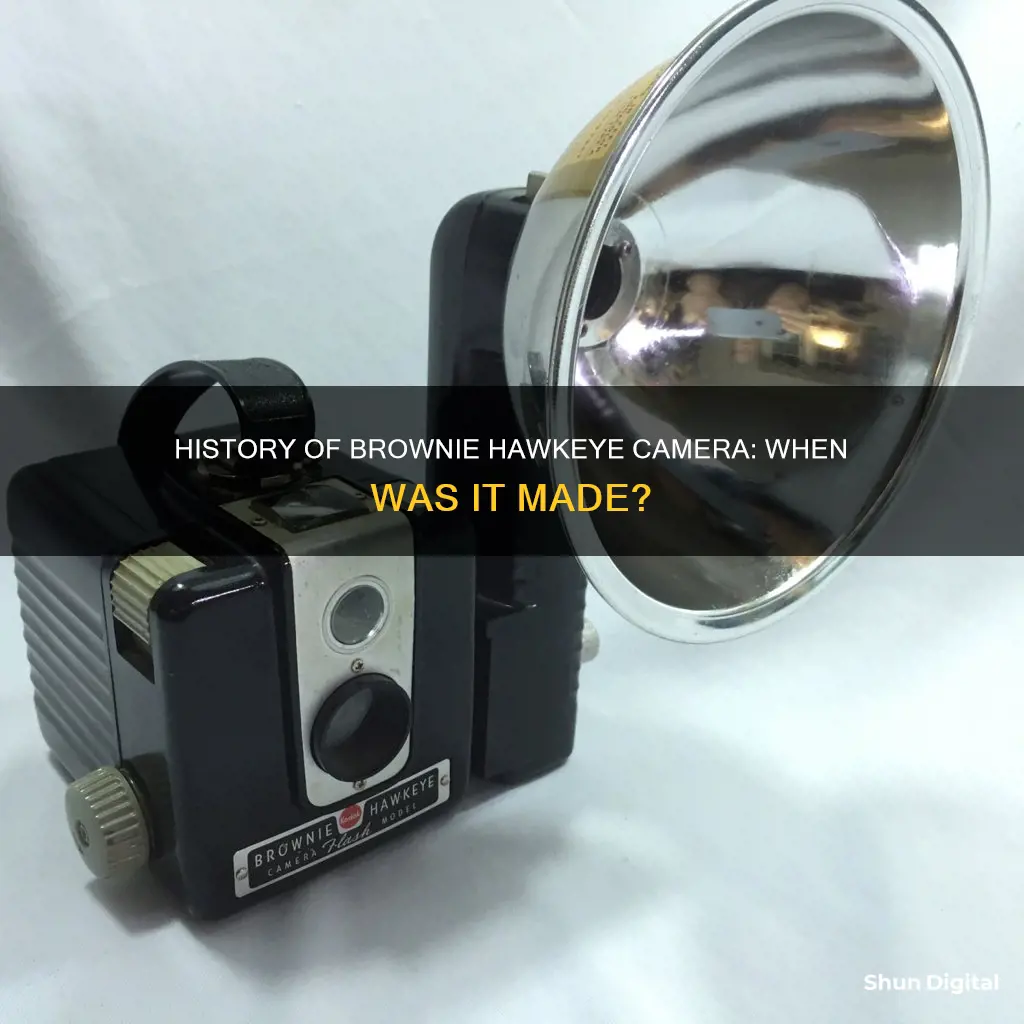
The Kodak Brownie Hawkeye is a simple plastic box camera produced between 1949 and 1961. It was manufactured in the USA, France, and Canada and was one of the many Kodak cameras called the Brownie. The Hawkeye is one of the most popular models to bear the name.
| Characteristics | Values |
|---|---|
| Date of Production | 1949-1961 |
| Film Type | 620 Roll (6x6) |
| Lens | Single Element Meniscus |
| Aperture | f/15 or f/16 |
| Shutter | Rotary, fixed-speed, approximately 1/30th-1/50th |
| Shutter Speeds | Instant or Bulb |
| Viewfinder | Waist-level finder |
| Cable Release Thread | No |
| Country of Manufacture | USA, France, Canada |
| Manufacturer | Kodak: Eastman Kodak, Rochester, New York, USA, Kodak Pathé, France, Canadian Kodak Co. Limited |
| Original Price | $5.50 |
What You'll Learn

The Brownie Hawkeye was produced between 1949 and 1961
The Brownie Hawkeye was first introduced in May 1949 and was discontinued in July 1961. The non-sync model was produced from May 1949 to November 1951, while the Flash model was produced from September 1950 to July 1961. The camera retailed for $5.50 (approximately $53 in today's money) when it was first introduced, making photography accessible to amateur photographers. The Brownie Hawkeye is one of the most popular models in the Brownie series of cameras made by Eastman Kodak, which was first released in 1900.
The Brownie Hawkeye has a waist-level viewfinder, a fixed-focus meniscus lens, and a rotary shutter. It features a switch that allows for "bulb" exposure, although no tripod socket is provided for long exposure shots. The camera also has a metal or plastic film advance knob, depending on the model year. The Brownie Hawkeye is known for its ease of use and is still popular with film photographers due to its low cost and ability to use 120 film without respooling.
The Brownie Hawkeye was designed by Arthur H. Crapsey, who also designed other popular Kodak cameras such as the Kodak Brownie Bull's-Eye and the Kodak Brownie Star series. The camera has a unique image quality due to its one-element uncoated lens, which results in soft corners and mild chromatic aberration. However, objects within the better part of the field depth are quite sharp and detailed, thanks to the large negative.
Finding the Camera Raw Plugin: Location Guide
You may want to see also

The camera was made in the USA, France and Canada
The Kodak Brownie Hawkeye is a camera with a moulded bakelite body and a brilliant viewfinder. It was introduced in May 1949 and discontinued in July 1961. The camera was made in the USA, France and Canada.
The non-synchronised, non-flash model was produced from May 1949 to November 1951. The Brownie Hawkeye Flash Model was introduced in September 1950 and was discontinued in July 1961. This model was capable of accepting a wide range of Kodak pin and screw flash attachments. The Brownie Hawkeye Flash was also manufactured in France as the Brownie Flash Camera.
The Brownie Hawkeye was designed by Arthur H. Crapsey, who also designed other popular Kodak cameras such as the Kodak Brownie Bull's-Eye and the Kodak Brownie Star series. The camera has a compact, box-shaped design with a carrying handle on top and a winding knob to the photographer's right. The aesthetic is a throwback to the Art Deco era of the 1920s, with clean, minimalist fluting on the sides and an attractively designed front.
The Kodak Brownie Hawkeye takes 12 6x6cm images on 620 film. The original design did not include a flash facility, but the Flash model was added in 1950 and was labelled Kodak Brownie Flash in France and Brownie Hawkeye Flash in the USA and Canada. The Brownie Hawkeye was made in the USA and France by Kodak between 1949 and 1961.
The camera has a brilliant waist-level finder, which has a lens similar to the taking lens and thus provides a decent preview of the framing. The camera also features a switch that allows for "bulb" exposure, although no tripod socket is provided to steady the camera during long exposure shots. The speed of the shutter when "bulb" is not used is not widely known, but it is estimated to be between 1/30th and 1/50th of a second.
Polaroid Camera Battery Requirements: What You Need to Know
You may want to see also

It was designed by Arthur H. Crapsey
The Kodak Brownie Hawkeye was designed by Arthur H. Crapsey, who also designed many other popular Kodak cameras. Crapsey was a designer of plastic box cameras with similar aesthetics, such as the Kodak Brownie Bull's-Eye and the Kodak Brownie Star series. He also designed more advanced cameras for Kodak in the 1940s and 1950s.
The Brownie Hawkeye, introduced in May 1949 and discontinued in July 1961, was a box rollfilm camera with a moulded bakelite body and a brilliant viewfinder. The camera was compact and box-shaped, with a carrying handle on top and a winding knob to the photographer's right. Its design aesthetic was a throwback to the Art Deco era of the 1920s, with clean minimalist fluting on the sides and an attractively designed front.
The Brownie Hawkeye was a popular camera that was easy to use and cheap to buy. It took 12 6x6cm images on 620 film and featured a rotary shutter and a fixed aperture of f/15. The camera had a bulb exposure setting and a waist-level viewfinder that provided a decent preview of the framing. However, it lacked a tripod socket, which made it challenging to steady the camera during long exposure shots.
The Brownie Hawkeye's original design did not include a flash facility, but a flash model was introduced in September 1950. This model was capable of accepting a wide range of Kodak pin and screw flash attachments. The flash model was recognised as one of the most popular Brownie cameras made and was manufactured in the US and France.
The Craft of Camera Bag Making
You may want to see also

The Brownie Hawkeye is a simple plastic box camera
The Hawkeye is a compact, box-shaped camera with a carrying handle on top and a winding knob on the right. Its design aesthetic is a throwback to the Art Deco era of the 1920s, with clean, minimalist fluting on the sides and an attractive front. The camera was designed by Arthur H Crapsey, who also designed other plastic box cameras with similar aesthetics, such as the Kodak Brownie Bull's-Eye and the Kodak Brownie Star series.
The Brownie Hawkeye is a Bakelite camera that takes 6x6cm images on 620 film. It has a basic, fixed-focus meniscus lens with a focal length of roughly 75mm and a fixed aperture of f/16. The camera features a waist-level viewfinder and a rotary shutter that fires at approximately 1/30 seconds. The original model did not have a flash facility, but a flash model was added in 1950. The flash model also allows external proprietary flash units to be mounted on the side of the camera.
The Brownie Hawkeye was marketed towards children and amateur photographers due to its simple controls and low price. Despite its simplicity, the camera was capable of producing very good results under the right conditions. It became popular, and many iconic shots were taken on Brownies, including photos of the iceberg that sank the RMS Titanic in 1912.
VTech Kidizoom Camera: What's in the Box?
You may want to see also

It was one of many Brownie models made by Kodak
The Brownie Hawkeye was produced by Kodak between 1949 and 1961. It was one of many Brownie models made by Kodak, which first released a Brownie camera in 1900. The Brownie was a series of camera models that introduced photography to the masses by addressing the cost factor that had previously put amateur photography beyond the reach of most people. The Brownie was a basic cardboard box camera with a simple convex-concave lens that took 2+1⁄4-inch square pictures on No. 117 roll film. It was conceived and marketed to sell Kodak roll films.
The Brownie Hawkeye was a simple plastic box camera with a fixed-focus meniscus lens and a focal length of roughly 75mm. It took 12 6x6cm images on 620 film. The camera was compact and box-shaped, with a carrying handle on top and a winding knob to the photographer's right. The design aesthetic was a throwback to the Art Deco era of the 1920s, with clean minimalist fluting on the sides and an attractively designed front. The Brownie Hawkeye was designed by Arthur H Crapsey, who also designed other plastic box cameras with similar aesthetics, such as the Kodak Brownie Bull's-Eye and the Kodak Brownie Star series.
The Brownie Hawkeye was first released as a non-sync model without a flash facility. This original model was produced from May 1949 to November 1951. In September 1950, a flash model was introduced, called the Brownie Hawkeye Flash. This model was capable of accepting a wide range of Kodak pin and screw flash attachments. The flash model was produced from September 1950 to July 1961. The flash model also allowed external proprietary flash units to be mounted on the side of the camera.
The Brownie Hawkeye was manufactured in the USA, France, and Canada. The camera was made in Kodak's flagship factory in New York, as well as by international subsidiaries in Canada and France.
Battery Exhausted: Quick Tips to Revive Your Camera
You may want to see also
Frequently asked questions
The Brownie Hawkeye camera was produced from 1949 to 1961. The non-sync model was produced from May 1949 to November 1951, and the flash model was produced from September 1950 to July 1961.
The Brownie Hawkeye camera was made by Kodak.
The Brownie Hawkeye is a simple plastic box camera that takes 6x6cm images on 620 film. It has a fixed-focus meniscus lens with a focal length of roughly 75mm and a fixed aperture of f/15 or f/16. The shutter speed is approximately 1/30 seconds, and the camera also has a "bulb" mode for longer exposures. The camera features a waist-level viewfinder and a carrying handle on top.







